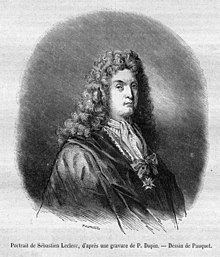Sebastien Le Clerc
| Sébastien Leclerc | |
|---|---|

Drawing of Leclerc by Pauquet after an engraving by P. Dupin.
|
|
| Born | September 1637 (baptised 26 September) Metz |
| Died | 25 October 1714 Paris |
| Nationality |
|
Sébastien Leclerc or Sébastien Le Clerc ([baptized] 26 September 1637— 25 October 1714) was a French artist from the Duchy of Lorraine. He specialized in subtle reproductive drawings, etchings, and engravings of paintings; and worked mostly in Paris, where he was counseled by the King's painter, Charles Le Brun, to devote himself entirely to engraving. Leclerc joined the Académie Royale de Peinture et de Sculpture in 1672 and taught perspective there. He worked for Louis XIV, being made "graveur du Roi" (attached to the Cabinet du Roi), doing engraving work for the royal house. Leclerc also engaged in periodic work as a technical draftsman and military engineer.
Of his reproductive engravings, the connoisseur and chronicler of artistic life, Pierre-Jean Mariette, wrote in his Abecedario:
"If there has ever been an engraver who rendered himself celebrated in his profession, and who extended his capabilities beyond ordinary bounds, that is, without fear of contradiction: Sébastien Le Clerc".
Sébastien Leclerc was born in 1637 in Metz; the son of Laurent Leclerc (1590–1695), a local goldsmith and merchant, who taught his son the rudiments of his trade. His first artistic efforts were favorably received in his birthplace, where he engraved a city view in 1650; four screens in 1654; and the "Life of Saint Benedict in 38 scenes" in 1658. Le Clerc went to Paris in 1665, where he pursued a continuing interest in geometry.
Leclerc's illustrated Géométrie Pratique was published in Paris in 1668. He was also a student of physics; military architecture; and perspective; while he supported himself by providing illustrations for authors and booksellers.
In 1673 Leclerc married one of the daughters of a royal dyer named Vandenkerchoven. Leclerc and his wife had six sons and four daughters. One of these, Sébastien "the Younger" (1676-1763), gained a reputation in painting.
Leclerc became engineer-geographer to Marshal de la Ferté. During this time, he executed plans of several fortresses in the Metz area. However, when he heard that the king had passed off one of his drawing's as another artist's work, he was unable to bear the affront and quit his job. Wishing to perfect his skills in military engineering, Leclerc moved to Paris (about 1665), where he could better study the subject. He carried letters of recommendation to the painter, Charles Le Brun. Upon seeing a sample of Leclerc's engravings, Le Brun advised him to abandon the sciences and devote himself solely to drawing and engraving under his tutelage. As the protégé of such a major artist, Leclerc had no trouble gaining commissions. Booksellers were eager to have his engravings decorate their books. His reputation rose quickly.
...
Wikipedia
